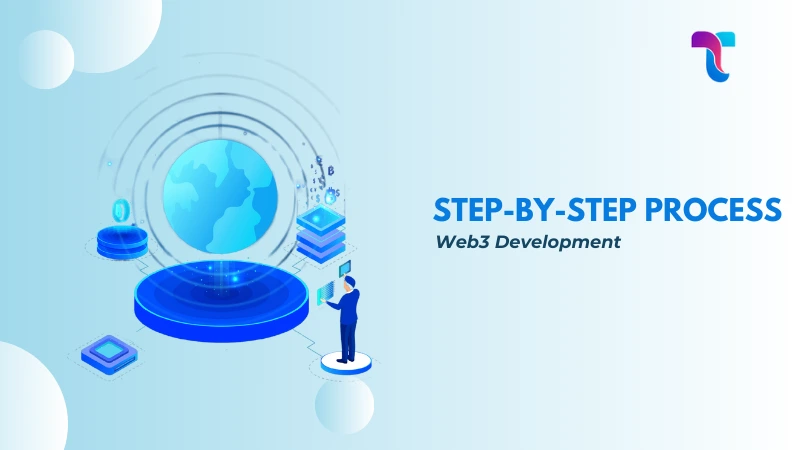In 2025, if you’ve browsed this post, then it is very obvious you’re curious to know how Web3 develops. Amazing, you’ve come to the right page.
Today, you’ll be going to uncover the step-by-step process of developing Web3. However, before that, let’s understand what Web3 really is.
Basically, Web3 is an advanced version of the internet that has revolutionized the world of decentralized applications. Since this technology came into action, it has been growing at a CAGR of 44.90%.
In addition to this, if we discuss its future expansion, then Web3 has witnessed rapid market expansion, which approximately stands at $27.5 billion by 2029.
Let’s develop Web3 with future-ready solutions!
How is Web3 Beneficial?
If we compare Web3 with the previous web, then after knowing about its advantages, you will surely fall in love with this advanced version of the internet.
Unlike Web2, Web3 offers decentralization and ownership. This means Web3 has taken away complete control from large corporations, giving more power to individual users and communities.
Additionally, earlier, users wouldn’t be able to access their data; now they’re gaining full ownership and control over their data, all while reducing the risk of privacy violations and data breaches.
Web3 applications are built on blockchain technology, which provides increased security and transparency and makes all the data tamper-proof.
Another core benefit of using Web3 is the use of smart contracts. This typically automates agreements and removes the need for a third party. With results, less cost, and more efficiency.
Thus, along with these benefits, Web3 also opens up several new opportunities for tokenization, decentralized autonomous organizations, and the creator economy. This fosters a more open, inclusive, and transparent digital economy.
Get Started With Web3 Development
After knowing about its benefits, it’s the right time to explore how you can begin building decentralized applications.
However, before that, you must be aware that Web3 development is not easy. Though it is becoming accessible with tools and communities, it still requires expert assistance. So, to simplify your development process, all you’re required to do is choose Technoloader as your partner.
Here’s how you can get started with your Web3 development:
Step 1: Set Up Blockchain Network
Your process of developing Web3 begins with setting up the blockchain network. In this step, you’re typically required to select the perfect blockchain platform, like Ethereum, Solana, or others, based on aspects like transaction speed, scalability, and gas fees.
However, developers might choose their own nodes for control or simply rely on easier providers like Infura, Alchemy, or QuickNode. Besides, tools like Hardhat, Truffle, etc., are mainly used to build a safe and secure development environment.
Step 2: Frontend and Backend Development
Once your blockchain network is in place, the next step you need to take is to expand the frontend and backend.
Meanwhile, the frontend is usually formed with a framework where users naturally interact with the application. It connects to the blockchain via libraries such as Web3.js, Ethers.js, and others.
Coming to the backend, it plays a meaningful role in managing off-chain operations like user profiles, metadata storage, or analytics. Decentralized storage solutions like IPFS and Filecoin are commonly used to sustain truthless and tamper-proof data storage.
Step 3: Programming of Smart Contract
After accomplishing both steps, your development will require handling the smart contract. These are the self-executing codes that command how any application works and are written in languages like Solidity for Ethereum and Rust for Solana.
For a seamless experience, developers repeatedly rely on frameworks like Hardhat or Truffle. Since smart contracts cannot be modified easily, special attention is provided to security, efficiency, and upgradeability to bypass costly issues.
Step 4: Set Up Wallet and Payment Gateway
Once your smart contracts are built, you’re required to set up a wallet and a payment gateway. Users need wallets such as MetaMask, Coinbase Wallet, or WalletConnect to interact with the platform and sign transactions.
However, crypto payment gateways can be combined to make seamless token purchases and transactions. This step enables users to engage with the application, all while keeping compliance with financial regulations.
Step 5: Testing
Once you’re done with all these procedures, the next step you need to take is testing. Before launching, it is essential to test reliability and security. Developers execute unit testing for individual smart contract functions and integration testing to secure smooth relations between the frontend and backend.
Testnets like Goerli, Sepolia, and more deliver safe environments. It further simulates real-world transactions without endangering actual funds. However, many projects might conduct audits with firms and launch bug bounty programs to strengthen security.
Step 6: Interoperable Environment
To protect your platform and make it future-ready, developers also concentrate on building interoperable environments. This means it will ensure that the application is authorized to communicate between multiple blockchains, all while operating bridges and cross-chain protocols.
Moreover, the middleware services like The Graph and Chainlink boost data retrieval and oracle integration. Layer-2 solutions like Optimism and Arbitrum help in scaling transactions at a lower price.
Step 7: Launch Your Platform
Finally, your platform is ready to launch on the mainnet. In this last step, you will normally be involved in deploying the tested smart contracts. Confirm them on explorers like Etherscan or Solscan, and make them public to users.
Thus, to promote adoption, teams often post tutorials, manuals, and onboarding materials. Also, the post-launch performance monitoring will help in tracking activity and areas for improvement. Continuous upgrades, user feedback, and, in some cases, community management will guarantee that the platform grows with market needs and stays competitive.
Conclusion
Web3 is an amazing area that’s constantly evolving and full of possibilities. While development can be complex, understanding the step-by-step process can make it easier and future-ready.
So, without waiting for more, it’s the right time to step in Web3. And if you are confused about how you can do so, here’s our Web3 guide that can help you that.
 +91 7014607737
+91 7014607737
 info@technoloader.com
info@technoloader.com



